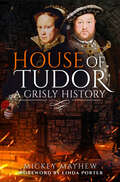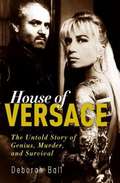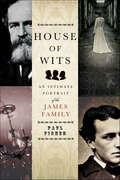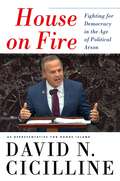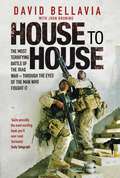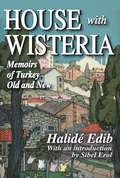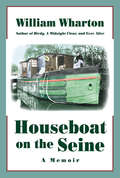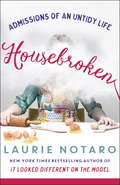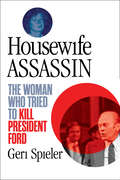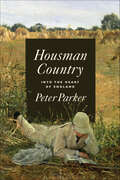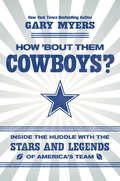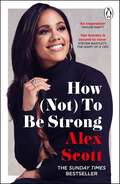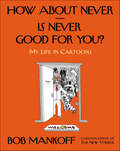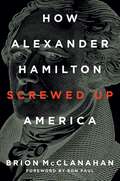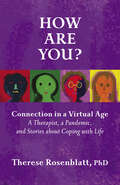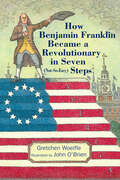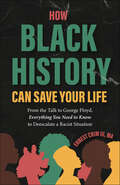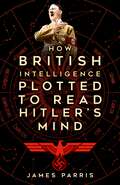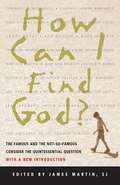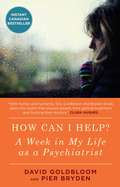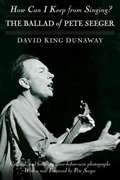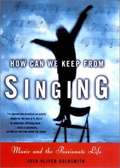- Table View
- List View
House of Tudor: A Grisly History
by Mickey MayhewForty-five gruesome but not gratuitous accounts from the Tudor reign, including the death of Richard III and the botched execution of Mary Queen of Scots. This decidedly darker take on the Tudors, from 1485 to 1603, covers a whole host of horrors from the Tudor reign. Particular attention is paid to the various gruesome ways in which the Tudors despatched their various villains and lawbreakers, from simple beheadings, to burnings and of course the dreaded hanging, drawing and quartering. Other chapters cover the various diseases prevalent during Tudor times, including the dreaded &“Sweating Sickness&”—rather topical at the moment, unfortunately—as well as the cures for these sicknesses, some of which were considered worse than the actual disease itself. The day-to-day living conditions of the general populace are also examined, as well as various social taboos and the punishments that accompanied them, i.e. the stocks, as well as punishment by exile. Tudor England was not a nice place to live by twenty-first-century standards, but the book will also serve to explain how it was still nevertheless a familiar home to our ancestors. &“He does not shy away from the gory details, which adds another element to stories that are familiar to those who are Tudor fans. If you want something spooky to read in October or know more about the darker side of Tudor history, I recommend reading House of Tudor.&” —Adventures of a Tudor Nerd &“It really does cover so many different things that there will be something for everyone whatever your interests are; political, personal, medical, or death. A brilliant gory discourse on my favourite period of history!&” —Tudor Blogger
House of Versace: The Untold Story of Genius, Murder, and Survival
by Deborah BallVersace. The very name conjures up images of outrageous glamour and bold sexuality, opulence and daring. All of course true, but only half the story. Versace is also the legacy of a great creative genius from a poor, backward part of southern Italy who transformed the fashion world through his intuitive understanding of both women and how a changing culture influenced the way they wanted to dress. The first book in English about the legendary designer, House of Versaceshows how Gianni Versace, with his flamboyant sister Donatella at his side, combined his virtuosic talent and extraordinary ambition to almost single-handedly create the celebrity culture we take for granted today. Gianni Versace was at the height of his creative powers when he was murdered in Miami Beach. The story was front page news around the world and the manhunt for his killer a media obsession. His beloved sister Donatella demanded no less than a funeral befitting an assassinated head-of-state to be held in Milan's magnificent cathedral. In what was the ultimate fashion show, the world's rich and beautiful - Princess Dianna, Elton John, Carla Bruni, Naomi Campbell, Carolyn Bessette-Kennedy, Anna Wintour and others - gathered to mourn a man already considered one of fashion's great pioneers. Deborah Ball, a long-time Milan correspondent forThe Wall Street Journal, conducted hundreds of interviews with Versace family members, Gianni Versace's lovers and business rivals, models such as Naomi Campbell whom he helped shoot to international stardom and fashion industry icons, including Anna Wintour, the legendary editor ofVogue. Ball vividly recounts the behind-the scenes struggles - both creative and business - of Donatella as she stepped out of her brother's long shadow and took control of the House of Versace. The book offers the first inside look at the enormous challenges Donatella faced in living up to Gianni's genius, her struggle with a drug habit, her battles with her brother Santo and the mystery of why Gianni left control of his house to Donatella's young daughter, Allegra. House of Versaceis a compelling, highly readable tale of rise from obscurity, a painful fall and ultimate redemption as the Versace empire returned to health - for now. Bringing together fashion, celebrity, business drama, jet-set lifestyles, and a notorious crime,House of Versaceis an old-fashioned page-turner about a subject of enduring fascination.
House of Wits: An Intimate Portrait of the James Family
by Paul FisherAn American odyssey that reveals the fascinating complexities of one of history's most brilliant, eccentric, and daring familiesThe James family, one of America's most memorable dynasties, gave the world three famous children: a novelist of genius (Henry), an influential philosopher (William), and an invalid (Alice) who became a feminist icon, despite her sheltered life and struggles with mental illness. Although much has been written on them, many truths about the Jameses have long been camouflaged. The conflicts that defined one of American's greatest families— homosexuality, depression, alcoholism, female oppression—can only now be thoroughly investigated and discussed with candor and understanding.Paul Fisher's grand family saga, House of Wits, rediscovers a family traumatized by the restrictive standards of their times but reaching out for new ideas and ways to live. He follows the five James offspring ("hotel children," Henry called them) and their parents through their privileged travels across the Atlantic; interludes in Newport and Cambridge; the younger boys' engagement in the Civil War; and William and Henry's later adventures in London, Paris, and Italy. He captures the splendor of their era and all the members of the clan—beginning with their mercurial father, who nurtured, inspired, and damaged them, setting the stage for lives of colorful passions, intense rivalries, and extraordinary achievements. House of Wits is a revealing cultural history that revises and completes our understanding of its remarkable protagonists and the changing world where they came of age.
House on Fire: Fighting for Democracy in the Age of Political Arson
by David N. CicillineCongressman David Cicilline offers his provocative takes on Republicans, Democrats, and the world of politics in the wake of Donald Trump. The rioters were still in the Capitol, shattering the door to the House Chamber and bellowing &“Hang Mike Pence,&” when David Cicilline, safely locked inside his office, began writing the articles of impeachment that would lead to Donald Trump&’s second Senate trial. He helped prosecute the case, earning admiration from his fellow progressives and a national following. But by summer he would be calling out some of those same colleagues for caving to special interests and attempting to block his plan to rein in the Big Tech companies like Facebook and Google. Beyond sounding an alarm, House on Fire identifies the key threat to our democracy—that the GOP has become a Trumpist authoritarian cult—and outlines how we fight back. A response that must include both citizen opposition and practical reforms, including an end to the Senate filibuster, discarding the Electoral College, expanding the Supreme Court, and requiring that justices adhere to a code of ethics. Cicilline actually believes in politics and the system. He used them both to deliver for the people in a once-corrupt city he ran as mayor and in Washington, where he has risen to help lead the Democratic Party in Congress. In HOUSE ON FIRE, Cicilline spares no one from criticism as he argues for a politics that produces results and warns that without it Trump, or someone worse, will take power in 2024 and make us wish for the days when the only thing we complained about was gridlock.
House to House: A Tale of Modern War
by John R. Bruning David BellaviaBringing to searing life the terrifying intimacy of hand-to-hand infantry combat, House to House is far more than just another war story. Populated by an indelibly drawn cast of characters, it develops the intensely close relationships that form between soldiers under fire. Their friendships, tested in brutal combat, would never be quite the same. What happened to them in their bloody embrace with America's most implacable enemy is a harrowing, unforgettable story of triumph, tragedy, and the resiliency of the human spirit. House to House is a soldier's memoir that is destined to rank with the finest personal accounts of men at war. An instant classic in hardcover, this timeless story features a new afterword and a question and answer section with the author.
House to House: An Epic Memoir of War
by Sgt. David BellaviaTHE CLASSIC SOLDIER&’S MEMOIR FROM MEDAL OF HONOR RECIPIENT STAFF SERGEANT DAVID BELLAVIA &“A rare and gripping account of frontline combat.&”—LTG (Ret.) H.R. McMaster, author of Dereliction of Duty &“They used to say that the real war will never get in the books. Here it does, stunningly.&” —Thomas E. Ricks, author of Fiasco: The American Military Adventure in Iraq and Making the Corps &“To read this book is to know intimately the daily grind and danger of men at war.&”—Anthony Swofford, New York Times bestselling author of JarheadOne of the great heroes of the Iraq War, Staff Sergeant David Bellavia captures the brutal action and raw intensity of leading his Third Platoon, Alpha Company, into a lethally choreographed kill zone: the booby-trapped, explosive-laden houses of Fallujah's militant insurgents. Bringing to searing life the terrifying intimacy of hand-to-hand infantry combat, this stunning war memoir features an indelibly drawn cast of characters, not all of whom would make it out alive, as well as the chilling account of the singular courage that earned Bellavia the Medal of Honor: Entering one house alone, he used every weapon at his disposal in the fight of his life against America's most implacable enemy. Bellavia has written an unforgettable story of triumph, tragedy, and the resilience of the human spirit.
House with Wisteria: Memoirs of Turkey Old and New
by Halide EdibThis edition of Halide Edib Adivar's Memoirs, prefaced with Sibel Erol's excellent introduction, is important and timely. When stereotypes of women in the Muslim world abound, Halide's memoirs remind us of the courage and dedication of "foremothers" who struggled for emancipation at both personal and national levels. These memoirs open a window on the search for personal expression of a woman caught up in the oppressive dynamics of her polygamous households (parental and marital), and the travails of national liberation and nation-building in Turkey, in which she played an active role. Halide speaks to us with an urgency which now cries out to be heard more than ever.Halide Edib's memoirs are indispensable reading for anyone interested in the history of childhood and education in the late Ottoman Empire. Edib worked to spread public education, instituting schools in Istanbul and in the Arab provinces during World War I. Her account is vibrant and direct, off ering an excellent witness to this critical period during which the Empire collapsed.Halide Edib lived through the most turbulent times in modern Turkish history. Most unusually for a woman of her day, she did so not only as an eyewitness, but as an active political participant. She was on close personal terms with powerful leaders such as Talat Pasha and Ataturk, but retained a critical and independent mind. All this gives her memoirs their unique character. The book provides new light on the Ottoman Empire and the Turkish nation.
Houseboat on the Seine
by William WhartonThe title brings to mind a luxury vessel on the most glamorous river in the world, but readers expecting to learn about the high life in France will be in for a surprise. In this charming memoir, painter and novelist Wharton (Birdy) instead gives us literally the nuts and bolts of building a houseboat, along with generous dollops of humor and local color. As a struggling artist in Paris with his schoolteacher wife and four children, Wharton decided to build his own boat after visiting that of an acquaintance in the mid-1970s. He recounts the family's adventures in making their dream come true. They gave up their Paris flat and moved onto the boat, which docked 12 miles downriver from Paris at Le Port Marly. There they spent the next 25 years adding the finishing touches. The most poignant moment comes at the wedding of oldest child, Kate, aboard ship. The author reminds us that she, her husband and their two children were to perish in 1988 in an Oregon fire, a tragedy he recounted in Ever After. Some readers might have preferred learning more about life aboard the boat than about the details of building it, but this work will satisfy Wharton devotees and Francophiles alike. (Jun. )
Housebroken: Admissions of an Untidy Life
by Laurie Notaro#1 New York Times bestselling author Laurie Notaro isn't exactly a domestic goddess--unless that means she fully embraces her genetic hoarding predisposition, sneaks peeks at her husband's daily journal, or has made a list of the people she wants on her Apocalypse Survival team (her husband's not on it). Notaro chronicles her chronic misfortune in the domestic arts, including cooking, cleaning, and putting on Spanx while sweaty (which should technically qualify as an Olympic sport). Housebroken is a rollicking new collection of essays showcasing her irreverent wit and inability to feel shame. From defying nature in the quest to make her own Twinkies, to begging her new neighbors not to become urban livestock keepers, to teaching her eight-year-old nephew about hoboes, Notaro recounts her best efforts--and hilarious failures--in keeping a household inches away from being condemned. After all, home wasn't built in a day.
Houses Made of Wood and Light: The Life and Architecture of Hank Schubart
by Jane Hickie Michele DunkerleyAmerican architect Hank Schubart was regarded as a genius for finding the perfect site for a house and for integrating its design into the natural setting, so that his houses appear to be as native to the forest around them as the trees and rocks. Salt Spring Island, one of the Gulf Islands in British Columbia, Canada, offered him a place to create the kind of architecture that responded to its surroundings, and Schubart-designed homes populate the island. Built of wood and glass, suffused with light, and oriented to views, they display characteristic features: random-width cedar siding, exposed beams, rusticated stonework. Over time, Schubart's homes on Salt Spring Island came to be considered uniquely Gulf Islands homes. This inviting book offers the first introduction to the life and architecture of West Coast modernist Henry A. Schubart, Jr. (1916-1998). While still in his teens, Schubart persuaded Frank Lloyd Wright to accept him as a Taliesin Fellow, and his year's apprenticeship in the master's workshop taught him principles of designing in harmony with nature that he explored throughout the rest of his life. Michele Dunkerley traces Schubart's career from his early practice in San Francisco at the noted firm Wurster, Bernardi & Emmons, to his successful firm with Howard Friedman, to his most lasting professional achievements on Salt Spring Island, where he became the de facto community architect, designing more than 230 residential, commercial, educational, and religious projects. Drawing lessons from his mentors over his decades on the island, he forged an everyday architecture with his mastery of detail and inventiveness. In doing so, he helped define how the island could grow without losing its soul. Color photographs and site plans display Schubart's remarkable homes and other commissions.
Housewife Assassin: The Woman Who Tried to Kill President Ford
by Geri SpielerThe authoritative true crime biography of a seemingly ordinary woman who nearly killed President Ford.President Gerald Ford suffered two attempts on his life during his term in office: one by Lynette “Squeaky” Fromme of the Manson Family, and the other by a far less likely candidate—an average middle-aged mother of five—Sara Jane Moore. After thirty years of communication with Moore in prison, journalist Geri Spieler provides a riveting account of her path from childhood in smalltown West Virginia to that fateful moment when she tried to assassinate the president.Throughout Moore’s dodgy life she hid her identity and misled those around her. Through the turbulent 60s and 70s, she married five times, abandoned children, faked amnesia, befriended Patty Hearst’s father, became a revolutionary, and worked as an FBI informant turned double agent feeding information to the underground radicals.From Spieler’s insider correspondence and independent research, including interviews with President Ford himself, she dissects the popular narrative—confirming some details and debunks others—and delivers a compelling profile of a society lady turned elusive assassin.
Housman Country: Into the Heart of England
by Peter Parker“Parker’s beautiful Housman Country tells you everything you want to know about the life and influence of England’s most satirised but inimitable poets.” —Evening StandardA New York Times Book Review Editor’s ChoiceNominated for the 2017 PEN/Bograd Weld Prize for BiographyA. E. Housman’s A Shropshire Lad made little impression when it was first published in 1896 but has since become one of the best-loved volumes of poetry in the English language. Its evocation of the English countryside, thwarted love, and a yearning for things lost is as potent today as it was more than a century ago, and the book has never been out of print.In Housman Country, Peter Parker explores the lives of A. E. Housman and his most famous book, and in doing so shows how A Shropshire Lad has permeated English life and culture since its publication. The poems were taken to war by soldiers who wanted to carry England in their pockets, were adapted by composers trying to create a new kind of English music, and have influenced poetry, fiction, music, and drama right up to the present day. Everyone has a personal “land of lost content” with “blue remembered hills,” and Housman has been a tangible and far-reaching presence in a startling range of work, from the war poets and Ralph Vaughan Williams to Inspector Morse and Morrissey.Housman Country is a vivid exploration of England and Englishness, in which Parker maps out terrain that is as historical and emotional as it is topographical.“[A] rich blend of literary criticism and cultural history.” —The Spectator
How 'Bout Them Cowboys?: Inside the Huddle with the Stars and Legends of America's Team
by Gary MyersWelcome to Jerryworld and an all-access pass to the most valuable sports franchise on the planet, the Dallas Cowboys.Many books have been written about the Cowboys, but there's never been an account like this one. HOW 'BOUT THEM COWBOYS tells the story of the NFL's most successful franchise, with special access to its outspoken owner, Jerry Jones, his sons Stephen and Jerry Jr., daughter Charlotte, and dozens of interviews of current and former players and coaches, and characters from across Cowboy Nation. While tracking the successes and controversies of some of the biggest names in the NFL on and off the field, HOW 'BOUT THEM COWBOYS? remembers the legends of previous generations, and explains why the star on the helmet has become iconic, and how a little expansion team from North Texas has evolved into a global $5 billion brand.Primed for their make-or-break 2018 season, HOW 'BOUT THEM COWBOYS? delivers a fun and surprising account of America's Team, its greatest celebrities, its mercurial management, the vicious rivalries, and the enduring saga that makes this the most popular and polarizing team in sports.
How (Not) To Be Strong: The inspirational instant Sunday Times Bestseller from the legendary Lioness
by Alex ScottAn inspiring memoir of finding strength and resilience from the former England Lioness.From the football cages of East London to broadcasting to millions, the engine powering Alex Scott's remarkable journey has always been her resilience. But thanks to a 'push-through mentality' the world has only ever seen the 'strong' side of Alex. Now, she is ready to lower the shield.In her candid memoir How (Not) to Be Strong, Alex shares the lessons that have shaped her, from finally confronting the legacy of a tumultuous childhood to tarnished truth behind the gleaming football trophies.With raw honesty, Alex shows how she's tackled life's challenges and that sometimes the strongest thing you can do is show your most vulnerable side to the world.
How A Shy Guy Like Me Earned Over $1 Million in Network Marketing
by Joe BrownExplains the system the author developed that earned him a big incum in network marketing.
How About Never—Is Never Good for You?: My Life in Cartoons
by Bob MankoffMemoir in cartoons by the longtime cartoon editor of The New YorkerPeople tell Bob Mankoff that as the cartoon editor of The New Yorker he has the best job in the world. Never one to beat around the bush, he explains to us, in the opening of this singular, delightfully eccentric book, that because he is also a cartoonist at the magazine he actually has two of the best jobs in the world. With the help of myriad images and his funniest, most beloved cartoons, he traces his love of the craft all the way back to his childhood, when he started doing funny drawings at the age of eight. After meeting his mother, we follow his unlikely stints as a high-school basketball star, draft dodger, and sociology grad student. Though Mankoff abandoned the study of psychology in the seventies to become a cartoonist, he recently realized that the field he abandoned could help him better understand the field he was in, and here he takes up the psychology of cartooning, analyzing why some cartoons make us laugh and others don't. He allows us into the hallowed halls of The New Yorker to show us the soup-to-nuts process of cartoon creation, giving us a detailed look not only at his own work, but that of the other talented cartoonists who keep us laughing week after week. For desert, he reveals the secrets to winning the magazine's caption contest. Throughout How About Never--Is Never Good for You?, we see his commitment to the motto "Anything worth saying is worth saying funny."
How Alexander Hamilton Screwed Up America
by Ron Paul Brion McclanahanHe is the star of a hit Broadway musical, the face on the ten dollar bill, and a central figure among the founding fathers. But do you really know Alexander Hamilton? <P><P>Rather than lionize Hamilton, Americans should carefully consider his most significant and ultimately detrimental contribution to modern society: the shredding of the United States Constitution.Connecting the dots between Hamilton’s invention of implied powers in 1791 to transgender bathrooms and same-sex marriage two centuries later, Brion McClanahan shows the origins of our modern federal leviathan.
How Are You?: A Therapist, A Pandemic, and Stories about Coping with Life
by Dr. Therese RosenblattA therapist shares her patients&’ experiences—and her own—during the dramatic disruption of the Covid crisis. By turns a memoir, a chronicle, and a provocative contemplation of life in a socially distanced and virtual world, How Are You? tells the story of a therapist plunged overnight into the unsettling reality of a pandemic and all-virtual therapy. Therese Rosenblatt shares her privileged front-row seat into the hearts and minds of her patients, to report on what has gone on inside real peoples&’ heads from the dark, early days of the pandemic through its long, drawn-out progression. Dr. Rosenblatt then trains her attuned eyes and ears onto herself, sharing some of her experiences and challenges—and unexpected pleasures—as she navigates this new world together with her patients. In addition to recounting how her patients are coping with loss, loneliness, and isolation, as well as overcrowding with relatives, spouses, and partners and challenges with substance use, she opens a window into her private thoughts as she conducts her sessions. All the while, she contemplates the specter of catastrophic illness and the move to an existence liberated from the physical space of the consulting room, yet missing its comforts and human sensibilities. Whether addressing difficult marriages, ambivalence about pregnancy, or young adults trying to launch into the world while locked down with their parents, Dr. Rosenblatt offers insight gleaned from twenty-six years of practice—and explores in depth this historic event&’s psychological effects on us as individuals.
How Benjamin Franklin Became a Revolutionary in Seven (Not-So-Easy) Steps
by Gretchen WoelfleHow did Ben Franklin become an outspoken leader of the American Revolution? Learn all about it in seven (not-so-easy) steps in this humorous, accessible middle-grade chapter book that focuses on Ben&’s political awakening.Famous founding father Benjamin Franklin was a proud subject of the British Empire—until he wasn&’t. It took nearly seventy years and seven not-so-easy steps to turn Benjamin Franklin from a loyal British subject to a British traitor—and a fired-up American revolutionary. In this light, whimsical narrative, young readers learn how Franklin came to be a rebel, beginning with his childhood lesson in street smarts when he buys a whistle at an inflated price. Franklin is a defiant boy who runs away from his apprenticeship, and while he becomes a deep thinker, a brilliant scientist, and a persuasive writer when he grows up, he never loses that spark. As a community leader who tries his best to promote peace and unity both between the colonies and with Great Britain, he becomes more and more convinced that independence for the American colonies is the way forward.Illustrated throughout with art by noted New Yorker cartoonist and illustrator John O&’Brien and sprinkled with quotations from Franklin, this unfamiliar story of a familiar figure in American history will surprise and delight young readers.
How Black History Can Save Your Life: Belonging at the Breaking Point
by Ernest Crim IIIBlack History's Power to Combat RacismHow Black History Can Save Your Life by Ernest Crim III, a hate crime survivor and Anti-Racist Educator, is an essential guide for anyone seeking to combat interpersonal racism, understand the roots of discrimination, and gain actionable strategies through Black historical narratives. This black history book for adults book empowers individuals, parents, and educators with tools to challenge racism and foster equity in their communities.Using Black history to fight racism. This book builds on Crim's personal experiences, including a viral 2016 hate crime incident that profoundly shaped his career. During a night out, Crim was targeted with racial slurs, but instead of letting it defeat him, he used the situation to highlight the pervasive nature of racism in America. He captured the moment on video, sparking a national conversation about the importance of confronting and addressing discrimination. Reclaiming the stories of Black history. Crim delves deep into the stories of Black excellence, resistance, and perseverance. He equips families, parents, and educators with the tools they need to combat racism in everyday life and within schools. Through his lens as a parent and former teacher, Crim demonstrates how the untold stories of Black history hold the keys to understanding the roots of racism and how it can be untaught. Drawing on his two bestsellers—Black History Saved My Life and The ABCs of Affirming Black Children—Crim teaches readers how to deconstruct racist systems and foster equitable practices in their communities. Inside, you&’ll find: Strategies to de-escalate and combat interpersonal racism in everyday situations. Tools for parents and educators to address racism in schools and educate children through an equitable lens. Inspiring Black history stories that provide a blueprint for resilience and empowerment in the face of discrimination. If you liked The Color of Law, Stamped from the Beginning, or Seven Sisters and a Brother, you&’ll love How Black History Can Save Your Life.
How British Intelligence Plotted to Read Hitler's Mind: How British Intelligence Plotted to Read Hitler's Mind
by James ParrisIn the darkest days of the Second World War, as Europe fell under Nazi domination and Britain faced invasion, Louis de Wohl, a 36-year-old refugee from Germany, made a curious offer to British Intelligence. Based on the widely held belief that Hitler’s every action was guided by his horoscope, de Wohl claimed he could reveal precisely what advice the Führer’s astrologers were giving him.Rather than dismissing de Wohl out of hand as a crank, senior intelligence officers and chiefs of staff of the three armed services took him at his word. De Wohl was made an army captain and quartered in the Grosvenor House Hotel, from where his one-man ‘Psychological Research Bureau’ passed astrological readings and assessments to the War Office, before his deployment to the United States by the highly secret Special Operations Executive on a propaganda mission.Was it possible that Military and Naval intelligence officers could take the ancient and arcane practice of astrology seriously? Was de Wohl genuine or merely a charlatan? Did his astrological readings contribute to the downfall of Hitler and Nazi Germany?In How British Intelligence Plotted to Read Hitler’s Mind, the first fulllength study of Louis de Wohl, James Parris examines the evidence – including material from MI5, Military and Naval Intelligence files at the National Archives – and reaches remarkable conclusions about this bizarre aspect of the Second World War.
How Can I Find God?: The Famous and the Not-So-Famous Consider the Quintessential Question
by James MartinThis vibrant collection brings together an array of voices addressing the question of how one might approach the search for God.
How Can I Help?: A Week in My Life as a Psychiatrist
by David Goldbloom Pier Bryden, M.D.A humane behind-the-scenes account of a week in the life of a psychiatrist at one of Canada’s leading mental health hospitals. How Can I Help? takes us to the frontlines of modern psychiatric care.How Can I Help? portrays a week in the life of Dr. David Goldbloom as he treats patients, communicates with families, and trains staff at CAMH, the largest psychiatric facility in Canada. This highly readable and touching behind-the-scenes account of his daily encounters with a wide range of psychiatric concerns—from his own patients and their families to Emergency Department arrivals—puts a human face on an often misunderstood area of medical expertise. From schizophrenia and borderline personality disorder to post-traumatic stress syndrome and autism, How Can I Help? investigates a range of mental issues. What is it like to work as a psychiatrist now? What are the rewards and challenges? What is the impact of the suffering—and the recovery—of people with mental illness on families and the clinicians who treat them? What does the future hold for psychiatric care? How Can I Help? demystifies a profession that has undergone profound change over the past twenty-five years, a profession that is often misunderstood by the public and the media, and even by doctors themselves. It offers a compassionate, realistic picture of a branch of medicine that is entering a new phase, as increasingly we are able to decode the mysteries of the brain and offer new hope for sufferers of mental illness.
How Can I Keep from Singing?: The Ballad of Pete Seeger
by David King DunawayHow Can I Keep from Singing? is the compelling story of how the son of a respectable Puritan family became a consummate performer and American rebel. Updated with new research and interviews, unpublished photographs, and thoughtful comments from Pete Seeger himself, this is an inside history of the man Carl Sandburg called "America's Tuning Fork." In the only biography on Seeger, David Dunaway parts the curtains on his life. Who is this rail-thin, eighty-eight-year-old with the five-string banjo, whose performances have touched millions of people for more than seven decades? Bob Dylan called him a saint. Joan Baez said, "We all owe our careers to him." But Seeger's considerable musical achievements were overshadowed by political controversy when he became perhaps the most blacklisted performer in American history. He was investigated for sedition, harassed by the FBI and the CIA, picketed, and literally stoned by conservative groups. Still, he sang. Today, Seeger remains an icon of conscience and culture, and his classic antiwar songs, sung by Bruce Springsteen and millions of others, live again in the movement against foreign wars. His life holds lessons for surviving repressive times and for turning to music to change the world. "This biography is a beauty. It captures not only the life of the bard but the world of which he sings." --Studs Terkel "A fine and meticulous biography ... Dunaway has taken [Seeger's] materials and woven them into a detailed, interesting, and well-written narrative of a most fascinating life." -American Music. "An extraordinary tale of an extraordinary man [that] will intrigue not only his legions of followers but everyone interested in one man's battles and victories." -Chicago Sun-Times.
How Can We Keep from Singing: Music and the Passionate Life
by Joan Oliver GoldsmithThe author has been a member of the Minneapolis/St. Paul Symphony Chorus for eight years, and has a lifelong love of choral singing. This book combines memoir with far-ranging reflections on singing, friendship, the corporate world, romantic love, and much more. Goldsmith writes beautifully and her words capture the beauty and exhilaration of singing, which she considers a spiritual experience.
